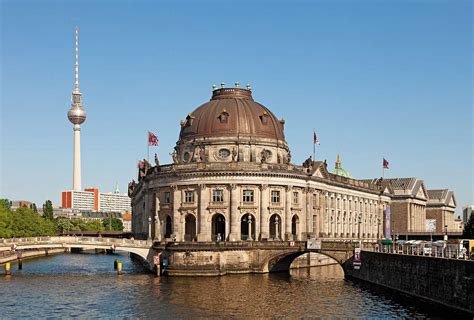Explore Germany’s cultural richness from its historical sites, diverse heritage, and vibrant festivals to its museums preserving traditions for future generations.Germany, a land steeped in history and culture, invites us on a captivating journey to explore its heart and soul through the tapestry of its museums and historical sites. This blog post is your personal guide to uncovering the fascinating layers of German cultural heritage. As you delve into this exploration, you will not only discover the importance and sheer diversity of the nation’s cultural artifacts but also how they are meticulously preserved for posterity. Each museum visit and walk through the echoing halls of history will transport you through time, offering a glimpse into Germany’s storied past. Meanwhile, traditional rituals and vibrant festivals continue to weave the rich threads of Germany’s identity. As we venture beyond display cases and through the cobblestone streets, we invite you to join us in celebrating and preserving Germany’s cultural legacy for the enlightenment of future generations.
The Importance and Diversity of German Cultural Heritage
German cultural heritage stands as a beacon of rich history and a mosaic of vibrant traditions that have shaped not only Europe but the entire world. Recognized for its profound influence in areas ranging from classical music to contemporary art, the diversity of this heritage manifests through its array of regional dialects, architectural wonders, and centuries-old customs. Delving into the depths of Germany’s history affords us a glimpse into the past where we can observe the birth of influential philosophies and the rise of significant movements that have irreversibly impacted humanity’s trajectory.
The range of German cultural landmarks spans across majestic castles, such as Neuschwanstein, which seem to be plucked right out of fairy tales, to the somber remnants of the Berlin Wall that once divided a nation yet now stand as a symbol of reunification and resilience. Each site embodies a chapter of Germany’s collective story, inviting onlookers to a journey through time. The cultural diversity of Germany is also mirrored in its gastronomy, with regional dishes ranging from the hearty Bavarian cuisine to the delicate seafood of the Northern coast, each telling a tale of the land’s geography and the people’s adaptation over centuries.
When one considers the unparalleled contributions of German thinkers and creators to the global artistic and intellectual pools – think of names such as Beethoven, Goethe, and Einstein – the importance of preserving and promoting this diverse cultural fabric becomes evident. These luminaries, among countless others, originated within the nurturing realm of German culture and continue to inspire innovation and creativity across borders. Furthermore, the nation’s heritage is rooted in its celebration of festivals and traditions such as Oktoberfest, the renowned beer and folk festival which projects the convivial spirit of German culture onto the world stage.
Therefore, understanding and appreciating the importance and diversity of Germany’s cultural heritage is pivotal for both historical comprehension and contemporary insight. As we forge into an ever-globalizing future, it becomes all the more crucial to foster a sense of identity and continuity, which are encapsulated in the rich tapestry of German heritage. Reflection upon these cultural treasures not only deepens our perspective of the past but also enriches our present by ensuring that the stories, traditions, and achievements of Germany are passed down to successor generations, informing our global legacy.
Discover the Rich History of Germany through Museums
Embarking on a journey through Germany’s robust museums offers an intimate portal into the nation’s soul, where every exhibit and gallery whispers tales of human endeavor, wars, renaissance, and revolutions. Strolling through the corridors of institutions like the Pergamonmuseum or Neues Museum in Berlin, one cannot help but be enveloped in the grand narrative of human history, whether admiring the majesty of ancient artifacts or contemplating the harrowing echoes of the 20th century’s tumult.
Engagement with Germany’s historical riches is not simply a passive experience; it’s an interactive dialogue with the past, encouraging personal reflection. For instance, the Deutsches Historisches Museum reveals layers of Germany’s past, offering diverse perspectives and critical contemplation which challenges visitors to piece together a mosaic of events and influences that shaped the modern German state. This experience underscores the importance of preserving history through thoughtful curation and presentation.
In the southern regions, museums like the Bavarian National Museum in Munich cast a spotlight on the unique Bavarian culture and artistry, framing the region’s contribution to Germany’s collective inheritance. Here, one can trace the evolution of Germanic craftsmanship and design, enriching the understanding of national identity through the lens of regional specificity—an integral tapestry thread in the country’s cultural quilt.
Moreover, it is within the solemn walls of institutions like the Jewish Museum in Berlin that the heavy chapters of German history are tenderly held and honored. These sacred spaces provide an environment of learning and remembrance, securing a pledge for a future built from the lessons of history. They are vital hubs where the past is preserved, allowing generations to explore the multifaceted cultural heritage that continues to shape Germany’s present and inspire its future.
Immersion in the Past: Visiting Historical Sites
An immersion in the past can provide a visceral connection to history that books and photos simply cannot match. Visiting historical sites across Germany offers a unique window into the events and lives that have shaped the national fabric. Standing amidst the ruins of a Roman fortress or within the solemn walls of a medieval church, one can almost hear the whispers of history, telling tales of yore.
Some of the most profound experiences come when one steps onto the cobblestone streets of towns that have seen the rise and fall of empires, felt the exuberance of revolution, and rebirthed after immense devastation. Places like the Brandenburg Gate or the remnants of the Berlin Wall stand as poignant reminders of Germany’s resilient spirit amid its tumultuous history. These historical sites serve as timeless educators, imparting lessons of endurance and hope.
Beyond the grandeur of castles and cathedrals, Germany’s rich historical tapestry is also evident in quieter, rural locales. Here, one might discover an ancient well whose waters have quenched the thirst of countless generations, or a centuries-old farmhouse that withstood the rigors of time, standing testimony to the everyday life of German ancestors. Such places provide texture to our understanding of the past, offering intimate perspectives on the continuum of human existence.
In each of these sites, there’s a sense that, by crossing their thresholds, one transcends the present moment, engaging in a silent dialogue with history. It’s a potent reminder that the past remains alive and well, ensconced in the stones, landscapes and indeed, the very soil upon which we walk. Thus, an immersion in the past, by way of visiting historical sites, is not merely an outing but a profound journey through time, a chance to ponder the narrative of human achievement and reflect on the legacies we will leave for future generations.
Unveiling Germany’s Cultural Identity: Traditions and Rituals
Germany’s cultural identity is steeped in a tapestry of rich traditions and rituals that resonate throughout the ages, painting a vivid picture of the country’s historical depth and contemporary zest. From the quaint lanes of Bavarian villages where ancient folk tales seem to flutter in the breeze, to the exuberant soundscapes of Berlin’s dynamic festivals, these practices are a cornerstone of what it means to experience Gemütlichkeit—the untranslatable feeling of warmth, friendliness, and good cheer inherent to the German way of life.
One cannot speak of German traditions without invoking the famed Oktoberfest—a swirling kaleidoscope of lederhosen, dirndls, and overflowing steins underpinned by the robust sounds of oompah bands. This world-renowned festival, held annually in Munich, is a monumental testament to the convivial spirit that suffuses German culture; it is where people from all walks of life gather in celebration of the county’s storied love affair with beer and comradery. Nevertheless, Oktoberfest is but one thread in the intricate cultural fabric of Germany’s heritage.
Delving deeper into the heart of Germany’s rituals, the ritualistic aspect of Christmas markets—the Christkindlmarkt—provides another glimmer into the captivating charm that German cultural practices espouse. Amidst rows of gingerbread-scented stalls and twinkling fairy lights, each market is a microcosm of regional handicrafts and longstanding yuletide customs, where the story of each tradition is as intriguing as the intricate wood carvings and hand-blown glass ornaments they inspire. Moreover, these cherished markets ennoble the communal reverence for the season, fostering a unique atmosphere of joy and anticipation.
In the solemnity of sacred spaces, Germany’s rituals echo with a resonance that transcends the mere acts—they become a dialogue with the past, reverberating into the present. Take, for example, the somber rituals of remembrance, which pay homage to Germany’s complex history and the lessons learned therein. Whether through candlelit vigils or silent moments at memorial sites, the commitment to never forget is a powerful invocation of the nation’s journey towards reconciliation and unity. As such, the rituals and traditions of Germany serve as both a mirror and a lantern—reflecting the soul of a nation while illuminating the path forward.
Preserving and Promoting German Cultural Heritage for Future Generations
The preservation and promotion of German cultural heritage are crucial endeavors to maintain the multifaceted narratives that have shaped Germany. What entails such a broad spectrum of actions is not just the safeguarding of tangible artifacts but perhaps even more so, the continuous passing down of intangible practices, knowledge, and stories to the youth. Engaging the younger generations with their historic lineage is a shared responsibility, involving policymakers, educators, cultural institutions, and communities alike.
It is widely understood that cultural heritage is a testimony to the historical depth and diversity of a nation. Germany, with its many regions, dialects, and customs, offers an abundance of such treasures—from Bavarian folk music to the craftsmanship of the Cuckoo clocks from the Black Forest. Ensuring that these unique aspects are preserved is only half the battle; equally important is finding innovative ways to promote these qualities in a manner that resonates with today’s digital and globalized world.
One innovative approach includes implementing digitization projects that capture and archive the vast wealth of German heritage. By doing so, the accessibility and reach of Germany’s cultural assets are significantly broadened, allowing global audiences a glimpse into the country’s soul. Educational systems have a role to play as well, as they can integrate cultural studies into curricula, thereby fostering a sense of pride and belonging among young Germans. Extracurricular activities, such as museum visits, heritage site tours, and participation in traditional festivals, serve to enrich the connection between German youth and their cultural legacy.
In conclusion, the challenge to preserve and promote German cultural heritage is ongoing and multifaceted. It entails the collaboration of various stakeholders and the adoption of new technologies and educational strategies. The objective is clear: to ensure that the cultural identity of Germany continues to flourish, inspiring and informing future generations. Only through such collective and continuous efforts can the stories, skills, and symbols of Germany’s rich past be secured as an invaluable part of the world’s cultural mosaic.
Exploring Germany’s Cultural Heritage Beyond Museums: Festivals and Events
When one ventures beyond the confines of conventional museums, they discover that Germany’s cultural heritage pulsates vibrantly in its myriad festivals and events. These celebrations are not just mere gatherings, but rather, they are a profound expression of the nation’s history and traditions, woven into the fabric of everyday life. Each festival is a window to the past, presenting an opportunity to experience the rich tapestry of German customs first-hand — from the exuberant parades of Karneval in Cologne, capturing the spirit of medieval pageantry, to the time-honored Oktoberfest in Munich, a world-renowned tribute to Bavarian culture and its love for finely brewed beer.
Moreover, these gatherings serve as a testament to Germany’s regional diversity, each territory showcasing festivities that highlight unique local legacies. The ‘Christkindlesmarkt’ of Nuremberg beckons with its enchanting Christmas markets, an annual affair that dates back to the 16th century, embodying the timeless charm of Yuletide cheer. Festivals such as the Rhein in Flammen (Rhine in Flames) illuminate the night skies with spectacular fireworks along the Rhine River, echoing the folklore and legends entwined with Germany’s most iconic waterway. In experiencing these events, one is not merely a spectator but becomes part of the living narrative that continues to shape Germany’s cultural identity.
As attendees of these festivals and events, visitors are granted the unique privilege to not only witness but participate in the preservation of the cultural heritage that Germans hold dear. It is in the clinking of steins, the chorus of traditional folk songs, and the collective merriment of the Fasching carnival that one finds the essence of a people and their way of life. Such experiences are invaluable, allowing for an authentic immersion that transcends the static displays of artifacts and into the lively realm of active cultural appreciation and understanding.
To encapsulate, it is through these festivals and events that the spirit of Germany’s cultural heritage truly comes alive. Each celebration offers a feast for the senses and a gateway to understanding the historical and social continuum that is central to the German ethos. To truly grasp the depth and breadth of Germany’s cultural fabric, one must look beyond museum walls and dive into the exuberant world of its festivals and events, each one a vibrant brushstroke painting the grand canvas of German history and identity.
Frequently Asked Questions
What makes German cultural heritage significant?
German cultural heritage is significant due to its vast and diverse contributions to the worlds of art, history, music, architecture, philosophy, and science. It reflects the country’s rich historical tapestry and complex past, influencing and shaping contemporary culture and thought globally.
How can someone learn about Germany’s history in its museums?
Germany’s history can be explored through a multitude of museums across the country. These institutions house extensive collections and exhibits ranging from prehistoric artifacts to modern art, offering visitors insights into various epochs, significant events, and influential figures that have shaped the nation.
Can you name a benefit of visiting historical sites in Germany?
Visiting historical sites in Germany allows individuals to immerse themselves in the environment where history unfolded. It provides a tangible connection to the past, enhances understanding of historical events and their impacts, and offers a unique perspective that cannot be replicated through other media.
What kind of traditions and rituals form a part of Germany’s cultural identity?
Germany’s cultural identity is shaped by numerous traditions and rituals, including folk festivals like Oktoberfest, Christmas markets, Carnival (Karneval/Fasching), traditional crafts, folk music and dances, as well as culinary customs like bread-baking and sausage-making.
Why is it important to preserve German cultural heritage for future generations?
Preserving German cultural heritage is crucial for maintaining a sense of identity and continuity, providing future generations with a window into their past. It serves as an educational resource, nurtures national pride, and ensures that cultural treasures are protected and celebrated for years to come.
Are there any specific festivals or events that showcase Germany’s cultural heritage?
Germany boasts numerous festivals and events that showcase its rich cultural heritage. Notable examples include the Berlin Film Festival, Rheingau Music Festival, Bach Fest in Leipzig, and historical reenactments like the Landshuter Hochzeit. Each event highlights a facet of Germany’s cultural diversity and history.
How is Germany’s cultural heritage diverse?
Germany’s cultural heritage is diverse due to the variance in historical influences across different regions, from Prussian traditions in the north to Bavarian customs in the south. Each region contributes distinct art, architecture, dialects, cuisine, and folk traditions, all of which form a multifaceted national heritage.


